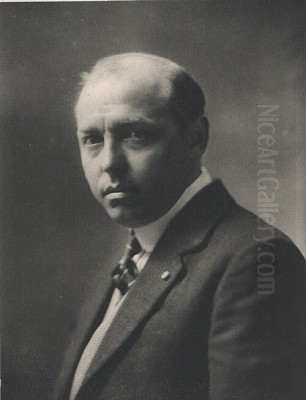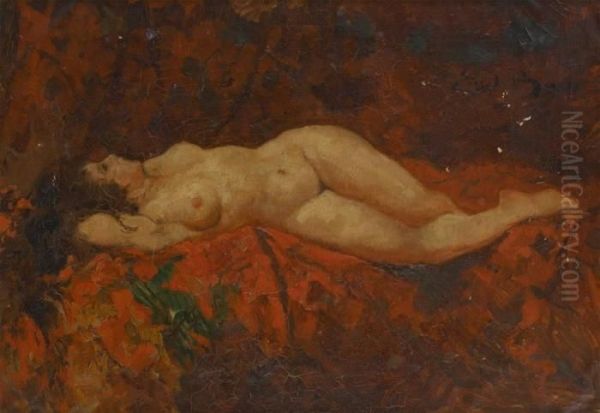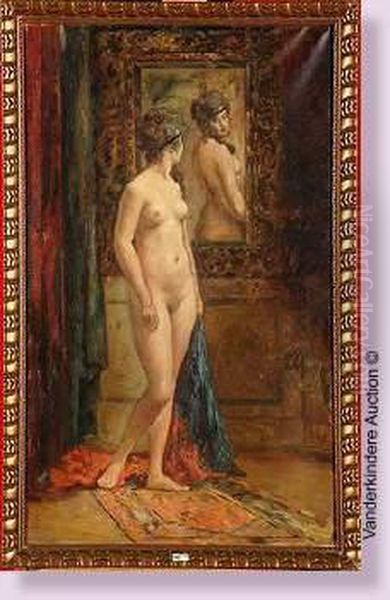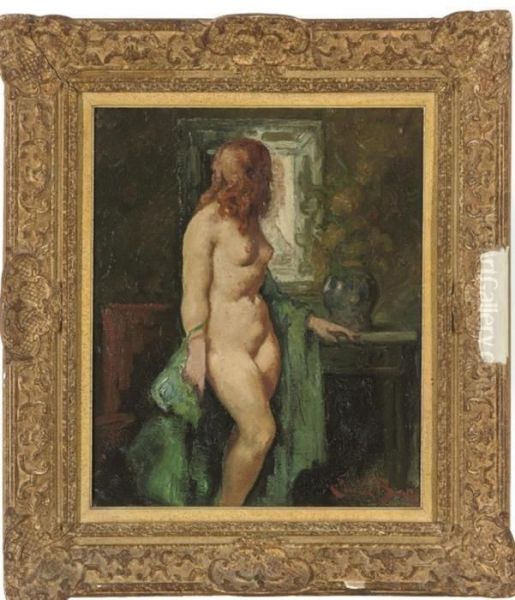
Emile Baes stands as a notable figure within the rich tapestry of Belgian art during the late nineteenth and early twentieth centuries. Born in 1879 and passing away in 1953, Baes dedicated his career primarily to painting, establishing a reputation for his sensitive portrayals of the human form, particularly nudes, as well as scenes drawn from everyday life and meticulously rendered interiors. Working predominantly in oil on canvas, his art reflects a strong grounding in academic tradition, combined with a personal sensibility attuned to the nuances of light, form, and atmosphere.
Though perhaps not as revolutionary as some of his contemporaries who embraced more radical avant-garde movements, Baes carved out a distinct niche. His work consistently demonstrates technical proficiency and a commitment to representational accuracy, characteristics likely honed during his formal artistic training. He remains recognized for his contributions to Belgian realism, leaving behind a body of work appreciated for its craftsmanship and quiet observation.
Early Life and Academic Foundations
Emile Baes was born in 1879, entering a Belgium that was a vibrant center for artistic activity. Brussels, in particular, was a hub where traditional academic approaches coexisted, often tensely, with emerging modern styles. To build his artistic career, Baes sought formal instruction, enrolling in the prestigious Académie Royale des Beaux-Arts (Royal Academy of Fine Arts) in Brussels. This institution was a cornerstone of artistic education in Belgium, upholding rigorous standards based on classical principles, drawing from life, and mastering anatomy and perspective.
Training at the Academy would have immersed Baes in a curriculum that emphasized draftsmanship and the careful study of Old Masters. Figures associated with the Academy around this period, like the influential director Jean-François Portaels earlier in the century, had cemented its reputation. While specific records of Baes's instructors aren't detailed in the provided sources, the environment itself fostered a deep respect for technical skill and the traditions of European painting. This academic background is evident throughout his oeuvre, particularly in his confident handling of human anatomy and his structured compositions.

The artistic climate in Brussels during Baes's formative years was dynamic. While the Academy represented the establishment, radical movements were challenging its dominance. Groups like Les XX (Les Vingt) and its successor La Libre Esthétique championed Impressionism, Neo-Impressionism, Symbolism, and Art Nouveau, showcasing artists like James Ensor and Fernand Khnopff. Baes, however, appears to have charted a course closer to the enduring traditions of realism, albeit infused with his own observational sensitivity, rather than aligning himself directly with these avant-garde circles.
Artistic Style and Dominant Themes
Emile Baes developed a distinctive artistic style characterized by realism, meticulous attention to detail, and a refined handling of paint. His brushwork is often described as fine and controlled, allowing for subtle gradations of tone and precise rendering of textures, whether depicting human skin, fabric, or the surfaces within an interior space. A key strength noted in his work is his ability to capture the play of light and shadow, using it to model forms convincingly and create a specific mood or atmosphere within the scene.
While grounded in realism, his approach sometimes carries a quality described as "cool realism," suggesting a certain objective distance or a focus on formal qualities over overt emotional expression. His color palettes are generally harmonious and naturalistic, reflecting the observed world accurately. This commitment to verisimilitude aligns him with a strong tradition of realism in Belgian art, stretching back through figures like Henri de Braekeleer and influenced by earlier Dutch and Flemish masters known for their genre scenes and interiors.
Thematically, Baes explored several subjects consistently throughout his career. He is particularly renowned for his nudes, which demonstrate his academic training in anatomy and his ability to portray the human form with both accuracy and sensitivity. Beyond the nude, his subjects included portraits, still lifes, landscapes, and intimate interior scenes, often depicting quiet moments of domestic life. These genre scenes showcase his skill in composing space and capturing the character of an environment, sometimes hinting at narrative possibilities without being overtly anecdotal.
Representative Works and Artistic Output
Several specific works help illustrate the scope and focus of Emile Baes's artistic production. One frequently cited painting is Standing nude with mirror in Japanese interior. The title itself suggests several key elements of his work: his mastery of the nude figure, his interest in interior settings, and a potential engagement with Japonisme – the influence of Japanese art and aesthetics that swept through Europe in the late 19th century. Such a work likely showcases his skill in rendering reflections and integrating the figure within a carefully described environment, possibly incorporating Japanese objects or design motifs popular at the time.

Other documented paintings, simply titled Nu and Nu au miroir (Nude with Mirror), reinforce his dedication to the theme of the female nude. These works, likely oil paintings, would further exemplify his academic grounding and his focus on form, light, and the intimate portrayal of the human body. The recurring motif of the mirror suggests an interest in complex spatial compositions and the themes of reflection, vanity, or introspection often associated with such imagery in art history.
Baes was not limited solely to painting. Evidence points to his work in sculpture as well, specifically a piece titled Nu allongé sur un canapé (Nude Reclining on a Sofa). This indicates his exploration of form in three dimensions, translating his understanding of anatomy and pose into a different medium. Furthermore, a triptych titled La Porte de l’Amour (The Door of Love) has appeared on the art market, suggesting he also tackled multi-panel formats, potentially exploring allegorical or symbolic themes. These examples highlight a versatile artist working within established genres but bringing his own distinct realist sensibility to each.
Context, Connections, and Contemporaries
Emile Baes practiced his art during a period of significant artistic ferment in Belgium and across Europe. While he maintained a connection to academic realism, he operated within an environment populated by diverse artistic currents. His works appeared in contexts alongside those of other notable Belgian artists. For instance, his paintings Nu and Nu au miroir were featured in a 2019 auction alongside Deux nus by Georges Lemmen (1865-1916). Lemmen was associated with Neo-Impressionism and was a member of the influential avant-garde group Les XX, highlighting the varied artistic landscape in which Baes's more traditional work also found a place.
Although direct records of Baes's personal interactions with many leading avant-garde figures are scarce in the provided sources, his life and work were inevitably situated within this broader context. Brussels was home to major Symbolist painters like Fernand Khnopff (1858-1921) and the highly individualistic James Ensor (1860-1949), whose expressive and often unsettling works offered a stark contrast to academic realism. The legacy of earlier Belgian realists, such as Constantin Meunier (1831-1905), known for his depictions of industrial workers, also formed part of the artistic heritage Baes inherited.

An important connection to later artistic developments, albeit indirect, comes through his daughter, Rachel Baes (1912-1983). Rachel became a painter in her own right, deeply influenced by Surrealism. She was active in Surrealist circles in both Brussels and Paris, associating with prominent figures like the writer Paul Éluard and the philosopher Georges Bataille. While Emile Baes's own style differed significantly, his daughter's career path demonstrates how the family was linked to the evolving currents of 20th-century art. Rachel's milieu would have included key Belgian Surrealists like René Magritte (1898-1967) and Paul Delvaux (1897-1994), further illustrating the artistic dialogues happening around the Baes family. Other contemporaries whose work formed the backdrop to Baes's career include the Neo-Impressionist Théo van Rysselberghe (1862-1926) and successful Belgian painters known internationally, like Alfred Stevens (1823-1906), who specialized in elegant depictions of modern life.
Later Life, Legacy, and Historical Evaluation
Emile Baes continued his artistic practice through the first half of the twentieth century, passing away in 1953 (some sources mention 1954, but 1953 appears more frequently cited). His work maintained a presence in the art world, appearing in exhibitions and, subsequently, on the art market. Auction records, such as the sale of his triptych La Porte de l’Amour for a sum between €1,500 and €2,500, indicate a continued collector interest in his paintings. This market presence reflects an appreciation for his technical skill and the appealing nature of his subjects.
Beyond the commercial sphere, Baes also participated in activities reflecting broader social concerns. Notably, he was involved in efforts to support the reconstruction of the Tokyo University library after the devastating Great Kantō earthquake of 1923, contributing artwork as part of an international donation drive organized by the League of Nations' Committee on Intellectual Cooperation. This act places him within a network of artists and intellectuals engaged in international cultural exchange and humanitarian efforts during the interwar period.
Historically, Emile Baes is regarded as a competent and respected Belgian painter of his generation. His primary legacy rests on his skillful adherence to realist principles, particularly in his sensitive rendering of the female nude and intimate interior scenes. While perhaps overshadowed in critical discourse by the more radical innovations of Belgian Symbolists, Expressionists like Ensor, or the later Surrealists including Magritte and Delvaux, Baes represents an important continuation of the academic and realist traditions within Belgian art. His influence is also seen through the artistic career of his daughter, Rachel Baes, who engaged with the very different path of Surrealism.
It is crucial to distinguish Emile Baes (1879-1953) from another Belgian artist with a similar name, Firmin Baes (1874-1943). Firmin Baes was known primarily for his work in pastels, often focusing on portraits and still lifes, and belongs to a slightly different, though overlapping, artistic context. Emile Baes's contribution lies firmly within the realm of oil painting, characterized by its detailed realism and focus on the human figure and genre scenes.
Conclusion
Emile Baes occupies a solid position within the narrative of Belgian art history as a dedicated painter working in the realist tradition. Spanning the late 19th and early 20th centuries, his career was marked by a consistent output of technically accomplished works, primarily oil paintings featuring nudes, portraits, and scenes of daily life. Educated at the Royal Academy of Fine Arts in Brussels, he mastered the academic principles of draftsmanship and composition, which provided a foundation for his detailed and carefully observed style.
While contemporary movements like Symbolism and Surrealism unfolded around him, Baes remained largely committed to representational painting, excelling in the subtle depiction of light, form, and texture. His works, such as Standing nude with mirror in Japanese interior, exemplify his skill and thematic interests. Though perhaps not an innovator in the mold of Ensor or Magritte, his art possesses a quiet integrity and enduring appeal. His legacy is preserved through his paintings, their continued presence in the art market, his contribution to international cultural efforts, and through the subsequent artistic path taken by his daughter, Rachel Baes, linking the family name to the ongoing evolution of modern art. Emile Baes remains a testament to the enduring power of skilled observation and traditional craftsmanship within the Belgian artistic landscape.